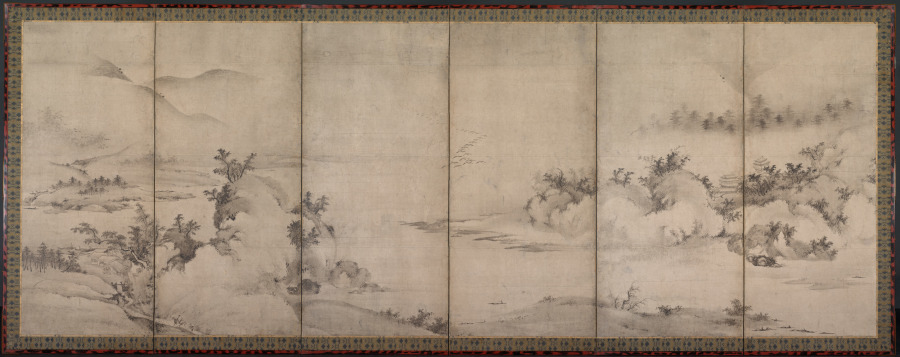| schema:description 9 | "wall_description: This screen by an Unkoku school artist is from a separated pair depicting the Eight Views of Xiao and Xiang Rivers, a popular Chinese Song dynasty painting and poetry theme that inspired many works in Japan and Korea. The location of the other screen is unknown. The views here are, from right to left: evening bell from a mist-shrouded temple, geese descending to a sandbar, sunset glow over a fishing village, and mountain village in clearing mist. The “crab-claw” style of the trees, in which the branches resemble the curved claws of a crab, and the stippling effect indicate a familiarity with Korean interpretations of Chinese Song dynasty painting styles. Painters of the Unkoku school—named for painter Sesshū Tōyō’s (1420–1506) residence in Yamaguchi at the southern tip of Japan’s main island of Honshu—were the stylistic descendants of Sesshū, and would likely have had access to many Korean paintings in the collection of their patrons, the Mori family....(more)" |
| schema:description | "tombstone: Landscape, 1500s. Japan, Muromachi period (1392-1573). Six-panel folding screen; ink on paper; painting: 129.5 x 350.8 cm (51 x 138 1/8 in.); framed: 145.5 x 366.8 x 62.5 cm (57 5/16 x 144 7/16 x 24 5/8 in.). The Cleveland Museum of Art, Gift from the Collection of George Gund III 2015.483...(more)" |
| schema:description | "culture: Japan, Muromachi period (1392-1573)" |
| schema:description | "id: 79590" |
| schema:description | "measurements: Painting: 129.5 x 350.8 cm (51 x 138 1/8 in.); Framed: 145.5 x 366.8 x 62.5 cm (57 5/16 x 144 7/16 x 24 5/8 in.)...(more)" |
| schema:description | "creditline: Gift from the Collection of George Gund III" |
| schema:description | "technique: six-panel folding screen; ink on paper" |
| schema:description | "collection: ASIAN - Folding screen" |
| schema:description | "type: Painting" |

